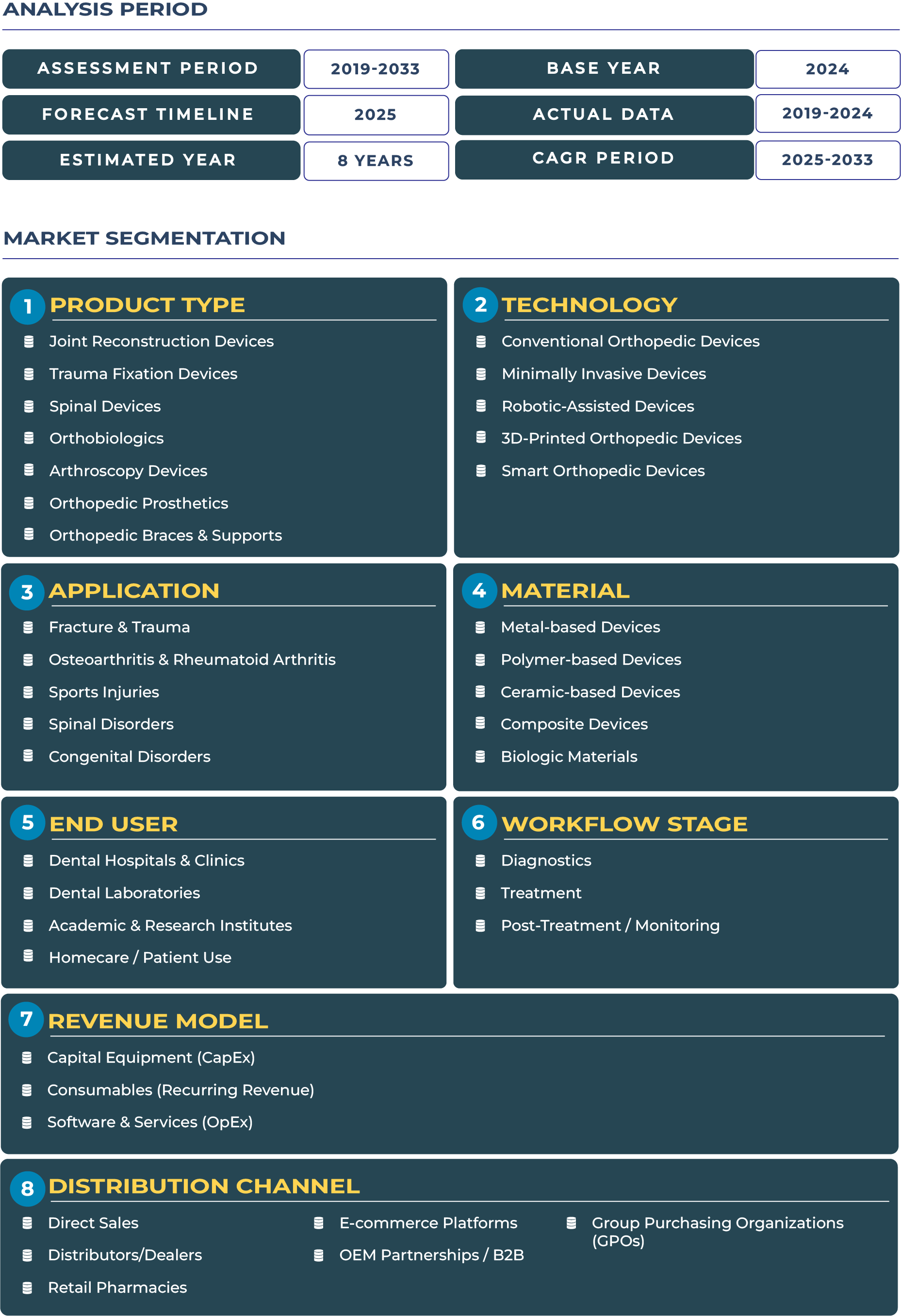Report Format:
![]()
![]() |
Pages: 110+
|
Pages: 110+
New Zealand’s Steady Orthopedic Adoption Backed by Public Funding: A Defining Outlook for 2025–2033
The New Zealand orthopedic devices market is progressing on a path of steady adoption, largely supported by its well-structured public healthcare funding. Unlike many larger markets, New Zealand benefits from a closely managed healthcare ecosystem where government allocations ensure continuity in access to critical medical devices, including orthopedic solutions. This stable public sector demand creates a resilient baseline for orthopedic device adoption, particularly for procedures like joint replacements and trauma fixation. According to DataCube Research, the market is projected to grow from USD 176.8 million in 2025 to USD 368.1 million by 2033, achieving a CAGR of 9.6%.
This growth is underpinned by multiple factors: a consistently aging population requiring orthopedic interventions, a strong network of regional hospitals, and growing private clinic contributions in metropolitan areas such as Auckland, Wellington, and Christchurch. Public funding stability ensures predictable procurement cycles, while private sector innovation contributes to niche orthopedic care advancements. These dynamics highlight New Zealand as a smaller yet steadily expanding orthopedic devices market with significant opportunities for manufacturers and service providers.
Growth Drivers and Hindrances in the New Zealand Orthopedic Devices Ecosystem
High Quality Standards and Public-Private Balance Elevating Adoption
A primary growth driver of the orthopedic devices industry in New Zealand is its balance between public system reliability and private clinic specialization. The public healthcare sector, managed by entities such as Ministry of Health New Zealand, provides consistent orthopedic care, including joint reconstruction and trauma-related procedures. This structure is similar to a compact NHS-like framework, where equitable access to devices is prioritized. At the same time, private clinics, particularly in urban areas, are expanding their offerings in advanced spinal devices and arthroscopy equipment, appealing to patients seeking faster treatment options and shorter waiting times.
New Zealand Orthopedic Devices market also benefits from high regulatory standards that align closely with international quality benchmarks, ensuring that implants, prosthetics, and biologics are durable and reliable. This quality-driven ecosystem boosts confidence among surgeons and patients alike, reinforcing demand for high-end devices. Together, these factors position the orthopedic devices landscape in New Zealand as small in volume but significant in reliability and patient outcomes.
Scale Limitations and Geographic Isolation Restraining Growth Potential
Despite its favorable demand environment, the orthopedic devices sector in New Zealand faces notable limitations. As a smaller market, it lacks the economies of scale enjoyed by neighboring regions, which restricts opportunities for rapid innovation and aggressive device launches. Centralized procurement, while cost-efficient, can slow down the adoption of new technologies and limit vendor diversity. This centralized system favors established players but can pose challenges for smaller, emerging orthopedic device companies seeking entry.
Another critical restraint is New Zealand’s geographic isolation, which raises logistics and distribution costs. Import-dependent segments, such as advanced spinal implants and orthobiologics, are particularly affected by shipping delays and global supply chain disruptions. Events such as pandemic-driven transport bottlenecks and geopolitical tensions affecting global trade routes have further underlined the country’s vulnerability. These limitations moderate the pace of growth, but they also encourage the industry to focus on long-term durability and value-added services to sustain performance.
Trends and Opportunities Reshaping the New Zealand Orthopedic Devices Landscape
Durable Implants, Tele-Rehabilitation, and Private Clinic Consolidation Leading Market Trends
One of the defining trends in New Zealand Orthopedic Devices market is the growing emphasis on durable implants. Hospitals and clinics, influenced by cost-conscious public payers, are prioritizing implants and prosthetics that reduce the need for replacement and revision surgeries. Alongside this, tele-rehabilitation and remote monitoring are gaining traction as the healthcare ecosystem adapts to post-pandemic realities. These digital-enabled solutions allow patients in regional and rural areas to receive follow-up orthopedic care without frequent hospital visits.
Private clinics are also undergoing consolidation, with groups expanding their footprints to serve wider patient bases. This consolidation fosters increased bargaining power for clinics when negotiating with device manufacturers, reinforcing the need for suppliers to innovate in terms of service contracts and bundled orthopedic care solutions.
Service Contracts and Tele-Enabled Rehabilitation Opening New Growth Pathways
The orthopedic devices industry in New Zealand is uncovering substantial opportunities in areas where value-added services complement traditional product offerings. Service contracts, particularly with regional hospitals, ensure continuous support for implants, arthroscopy equipment, and trauma fixation devices. By integrating after-sales service with product provision, suppliers are able to reduce the frequency of replacements while enhancing device performance in the long run.
Another opportunity lies in the expansion of tele-enabled rehabilitation services. With a dispersed population, New Zealand’s healthcare providers are increasingly adopting digital platforms to monitor patients recovering from orthopedic procedures. This reduces the strain on physical facilities while offering convenience to patients. Manufacturers who align their products with tele-rehab systems—whether through software integration or device compatibility—are likely to establish strong market differentiation.
Competitive Landscape: Global Expertise Meets Localized Healthcare Realities
The New Zealand orthopedic devices market features contributions from both international and local players. Global leaders such as Johnson & Johnson MedTech New Zealand continue to expand their presence, supplying joint reconstruction and trauma devices to both public hospitals and private clinics. Their durable product offerings and integrated service models align well with the public sector’s focus on value-for-money procurement.
Local orthopedic distributors and service providers are increasingly collaborating with international manufacturers to overcome logistics challenges and provide region-specific after-sales support. A key competitive strategy involves leveraging logistics partnerships to maintain steady supply chains despite geographic isolation. Additionally, pilot projects in tele-rehabilitation supported by device makers are gaining momentum, aligning with the healthcare sector’s digital health initiatives. The competitive landscape thus reflects a blend of durable premium products, localized service offerings, and collaborative innovation, shaping the future of orthopedic care in New Zealand.







